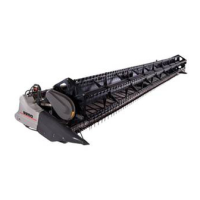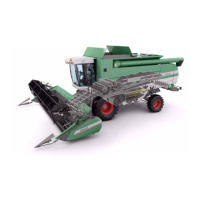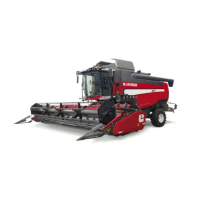Rotor loss
1. Remove the straw spreader, the chaff spreader and raise the shoe
tailboard so that shoe and rotor discharge remain separate.
2. Count the grain i
n a one-foot run of the rotor discharge path, which is
24 inches wide to ensure that all grain is counted.
• Remember to subtract any pre-harvest loss, grain loss caused by
the header, or loss due to combine leaks in the field!
• Use TABLE 2 on the previous page to determine total grain
loss from the rotor.
ROTOR LOSS EXAMPLE: a wheat farmer has a 40-foot wide header.
He removes the straw spreader, the chaff spreader, and raises the shoe
tailboard. He counts a total of 120 kernels of wheat in the rotor discharge
path (2 feet wide and 1 foot long). With a 40-foot header, it takes 760
kernels counted to equal one bushel loss, so 120 ÷ 760 = 0.16 bushels lost
per acre from the rotor.
Shoe loss
1. Remove the straw spreader, the chaff spreader and raise the shoe
tailboard so that shoe and rotor discharge remain separate.
2. Count or weigh the grain i
n a one-foot run of the shoe discharge path,
which is effectively five feet, to ensure that all grain is counted.
• Remember to subtract any pre-harvest loss, grain loss caused by
the header, or loss due to combine leaks in the field!
• Use TABLE 2 on the previous page to determine total grain
loss from the shoe.
SHOE LOSS EXAMPLE: a corn farmer has a 12-row, 30-inch corn head,
which equals a 30 foot swath. He removes the straw spreader, the chaff
spreader, and raises the shoe tailboard. He counts a total of 28 kernels of
corn in the path behind the shoe (5 feet wide and 1 foot long). With a 30-
foot header, it takes 60 kernels of corn to equal one bushel loss,
so 28 ÷ 60 = 0.47 bushels lost per acre from the shoe.
If time does not allow for quantifying the grain over the full width of the shoe,
individual square foot quantities can be averaged, and multiplied by 5 to
compare with TABLE 2 on the previous page.
27

